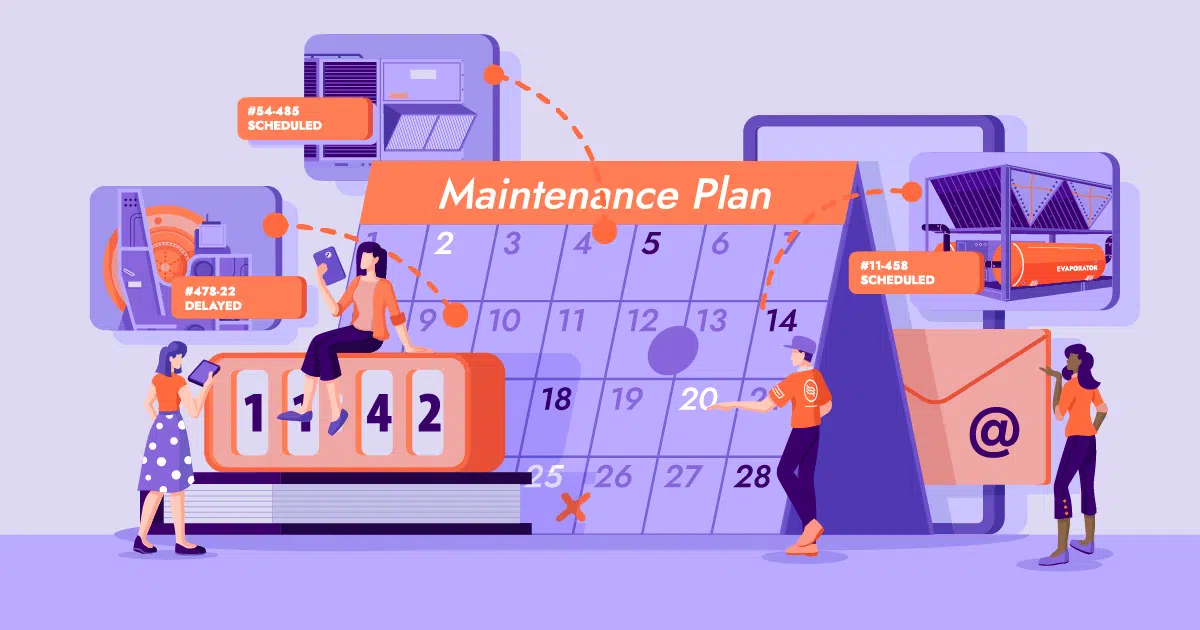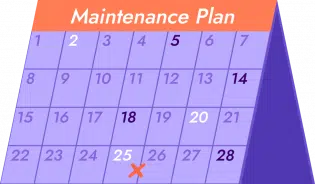Furnace Maintenance Guide: Maximizing Efficiency and Lifespan

When it comes to keeping your furnace systems in tip-top shape, regular maintenance is the name of the game.
But it’s not just about providing warmth—it’s also about optimizing efficiency, reducing energy costs, and extending the lifespan of equipment. In this blog post on commercial HVAC, we’ll dive into the importance of annual furnace maintenance and provide you with a comprehensive guide to maximize efficiency and extend the lifespan of your equipment. So grab a cup of coffee and let’s get started!
Understanding Your Furnace System
To kick things off, let’s familiarize ourselves with the key components of a furnace system that require routine maintenance. Understanding how these components work and how they contribute to the overall operation of your furnace will empower you to maintain them effectively. Each of these will be important to remember in your annual furnace maintenance checklist.
One critical component is the furnace filter. The filter plays a crucial role in maintaining indoor air quality by trapping dust, allergens, and other particles. Over time, the filter can become clogged, impeding airflow and reducing the efficiency of your furnace. Regularly cleaning or replacing the filter ensures optimal airflow and prevents unnecessary strain on the system.
Another vital part is the blower motor. The blower motor circulates air throughout your HVAC system, enabling efficient heat distribution. It’s important to check the blower motor regularly for any signs of wear and tear, lubricate it if necessary, and ensure it’s functioning at its best.
Lastly, the heat exchanger is a fundamental component responsible for transferring heat from the combustion process to the air that flows through your system. A cracked or damaged heat exchanger can lead to dangerous carbon monoxide leaks. Regular inspection and maintenance of the heat exchanger are crucial for the safety and efficiency of your furnace system.
By understanding the roles and functions of these components, you can prioritize their maintenance, keeping your furnace system in optimal condition.
The Importance of Regular Furnace Maintenance
Consistent maintenance is the secret sauce for keeping your furnace system running smoothly and maximizing its lifespan. Regular care and attention ensure that your equipment operates at peak efficiency, minimizing energy waste and reducing operational costs. It also helps identify potential issues before they escalate into major problems that require costly repairs or even complete system replacements.
Let’s talk about the cost savings from regular maintenance. When your furnace is well-maintained, it operates efficiently, reducing energy consumption and lowering utility bills. By regularly cleaning or replacing filters, for example, you ensure proper airflow, allowing your furnace to work optimally without straining itself. Additionally, routine maintenance helps identify and address minor issues early on, preventing them from snowballing into major malfunctions that could disrupt your business and require costly emergency repairs.
Moreover, regular maintenance enhances the longevity of your furnace system. By taking proactive measures and addressing small issues promptly, you can extend the lifespan of your equipment. This means you’ll get more mileage out of your investment and avoid the need for premature replacements, which can be a significant expense.
In a nutshell, regular furnace maintenance is essential for optimizing efficiency, reducing operational costs, and maximizing the lifespan of your equipment. By prioritizing maintenance tasks and implementing a preventive approach, you’ll reap the benefits in terms of improved performance, cost savings, and satisfied customers.
Essential Checks for Furnace Systems
Now, let’s get down to the nitty-gritty of furnace maintenance. We’ve compiled a handy checklist of essential tasks to help you prevent breakdowns and ensure optimal performance. By incorporating these checks into your routine maintenance, you’ll catch issues early on and keep your furnace humming happily.
First and foremost, checking for leaks is crucial. Inspect the entire furnace system, including the heat exchanger, pipes, and connections, for any signs of leaks. Leaks not only compromise the efficiency of your furnace but can also pose safety risks. Any detected leaks should be addressed promptly by a qualified technician.
Next, it’s important to keep your furnace system free from dust and debris. Regularly clean the various components, including the blower motor, fan blades, and other accessible parts. Dust and debris can accumulate over time, obstructing airflow and diminishing performance. A clean system not only operates more efficiently but also ensures better indoor air quality for your customers.
Proper airflow is essential for your furnace system to function optimally. Check for any obstructions or blockages in the air vents, ductwork, or registers. Ensure that the airflow is not restricted and that all vents are clean and unobstructed.
Moving parts within your furnace system are subject to wear and tear. Regularly inspect belts, pulleys, and bearings, and look for signs of damage or excessive wear. Lubricate these parts as recommended by the manufacturer to reduce friction and prolong their lifespan.
Additionally, pay attention to the condition of electrical connections and wiring. Loose or damaged connections can lead to system malfunctions or even safety hazards. Inspect these components and address any issues promptly to maintain the integrity of your furnace system.
By incorporating these essential checks into your regular maintenance routine, you’ll identify potential issues early on and ensure that your furnace system operates at its best.
The Role of Preventive and Predictive Maintenance in Furnace Systems
When it comes to maintenance strategies, preventive and predictive approaches are your best friends. Let’s take a closer look at how each contributes to the longevity and efficiency of your furnace systems.
Preventive maintenance involves regular inspections, cleaning, and servicing to prevent issues from arising. By adhering to a scheduled maintenance plan, you can identify and address potential problems before they cause system failures or disruptions to your business. Preventive maintenance tasks include cleaning or replacing filters, lubricating moving parts, checking electrical connections, and inspecting the overall condition of your furnace system. This proactive approach helps maintain optimal performance, prevent breakdowns, and extend the lifespan of your equipment.
On the other hand, predictive maintenance utilizes data and analytics to anticipate potential problems and take proactive measures. By monitoring system performance, analyzing historical data, and leveraging technologies such as sensors and IoT devices, you can detect anomalies or patterns that indicate impending issues. Predictive maintenance allows you to address these issues before they cause system failures, resulting in reduced downtime and more efficient resource allocation.
Combining preventive and predictive maintenance strategies provides a comprehensive approach to furnace maintenance. By proactively addressing known issues and leveraging data-driven insights, you can ensure the longevity and reliability of your furnace systems, minimizing disruptions to your business and maximizing customer satisfaction.
The Significance of Regular Cleaning and Filter Replacement
Regular furnace cleaning and filter replacement are two essential tasks in furnace asset maintenance. Let’s delve into why they are important and provide practical tips on performing these tasks effectively.
Cleaning a furnace system on a regular basis has several benefits. It helps remove dust, debris, and other contaminants that can accumulate over time and hinder proper airflow. By ensuring unobstructed airflow, you allow your furnace system to operate at its optimal capacity, improving efficiency and reducing energy consumption. Moreover, a clean system contributes to better indoor air quality, providing a healthier and more comfortable environment for your customers, and a higher energy efficient rating.
When it comes to air ducts, and filter replacement, it’s important to follow the manufacturer’s recommendations. Filters play a crucial role in trapping airborne particles, allergens, and dust, preventing them from circulating in the air. Over time, filters become clogged and lose their effectiveness. A clogged filter restricts airflow, forcing your furnace to work harder and potentially causing system malfunctions. By regularly replacing filters, you ensure proper airflow, improve efficiency, and maintain good air quality.
Here are some practical tips for cleaning your furnace system effectively:
Safety first: Before starting any maintenance tasks, always ensure that the power to the furnace is turned off to avoid accidents or electric shocks.
Cleaning the exterior: Start by cleaning the exterior of the furnace. Use a damp cloth to wipe away any dust or dirt that has accumulated on the surface. Avoid using abrasive cleaners or harsh chemicals that could damage the finish.
Cleaning the blower motor and fan blades: Remove the access panel to gain access to the blower motor and fan blades. Use a soft brush or vacuum cleaner with a brush attachment to gently remove dust and debris. Take care not to damage any delicate components.
Cleaning the heat exchanger: Cleaning the heat exchanger requires professional expertise and specialized tools. It’s best to leave this task to a qualified technician during routine inspections.
Filter replacement: Follow the manufacturer’s instructions for filter replacement. Typically, filters should be replaced every 1-3 months, depending on usage and the type of filter used. When replacing the filter, make sure to install it correctly, following the directional arrows indicated on the filter.
By regularly cleaning your gas furnace system and replacing filters as needed, you ensure optimal performance, improve energy efficiency, and promote good indoor air quality. It’s a simple yet effective way to maintain the health and longevity of your equipment. It also helps you ensure there are no defects that can lead to hazards such as carbon monoxide poisoning, or a cracked heat exchanger. Keep your furnace maintenance cost low and boost safety with regular furnace cleaning and a maintenance checklist.
The Importance of Routine Inspections and Health Check-ups
Routine inspections and health check-ups are like routine doctor visits for your furnace system. They play a vital role in maintaining its efficiency, safety, and overall performance. Let’s dive into the significance of these inspections and highlight what you should look for during these check-ups.
Routine inspections conducted by a qualified technician are crucial for identifying potential issues before they escalate into major problems. During an inspection, the technician will thoroughly assess your furnace system, checking for any signs of wear and tear, leaks, or malfunctioning components. They will inspect critical parts such as the heat exchanger, air filter, burners, blower motor, ignition system, and electrical connections. Additionally, they will verify the accuracy of temperature and pressure readings, ensuring the system is operating within optimal parameters.
During these inspections, technicians may also perform tests to assess the combustion efficiency of the system, ensuring it’s operating safely and not producing hazardous gases such as carbon monoxide. By identifying any issues or abnormalities, technicians can address them promptly, preventing safety hazards, improving efficiency, and prolonging the lifespan of your furnace system.
Apart from inspections, regular health check-ups are recommended to maintain the efficiency of your furnace system. These check-ups involve monitoring various performance metrics, such as airflow, temperature differentials, and energy consumption. By tracking these metrics over time, you can identify trends or anomalies that may indicate potential problems. Additionally, health check-ups may involve assessing the condition of filters, cleaning or lubricating moving parts, and ensuring proper calibration of thermostats and controls.
Routine inspections and health check-ups provide peace of mind, knowing that your furnace system is operating safely and efficiently. By scheduling these appointments with qualified technicians at regular intervals, you can address issues early on, optimize performance, and minimize the risk of unexpected breakdowns.
Preparing for Unexpected Setbacks: The Role of Spare Components and Emergency Repairs
No matter how well-maintained your furnace system is, unexpected setbacks can still occur. That’s why it’s important to be prepared for such situations. By having spare components on standby and establishing procedures for emergency repairs, you can minimize downtime, keep your business running smoothly, and ensure the comfort of your customers.
Maintaining an inventory of spare components is a proactive approach to handle unforeseen breakdowns. Some critical components that are prone to failure include igniters, flame sensors, control boards, and motors. By having these components readily available, you can quickly replace faulty parts and restore the functionality of your furnace system. Regularly check the condition of spare components to ensure they are in working order and replace them as needed to maintain an up-to-date inventory.
Establishing procedures for emergency repairs is equally important. Clearly define the steps to be taken in case of a breakdown, including whom to contact, escalation procedures, and emergency service providers. Train your team on these procedures to ensure a prompt response during emergencies. Additionally, keep a record of emergency service providers who are available 24/7 and have experience in furnace repairs. Having these contacts readily accessible will save valuable time during critical situations.
Remember, being prepared for unexpected setbacks is all about minimizing downtime, ensuring customer satisfaction, and maintaining the smooth operation of your business. By having spare components on standby and well-defined procedures in place, you can swiftly address emergencies, minimize disruptions, and provide efficient and reliable service to your customers.
Leveraging FieldInsight for Furnace Maintenance
Now, here’s where things get exciting! Meet FieldInsight, your trusty companion in furnace maintenance. FieldInsight is a comprehensive software solution designed specifically for field service businesses like yours. Let’s explore how its features can revolutionize how you manage furnace maintenance tasks and streamline your operations.
One of the key advantages of FieldInsight is its robust scheduling and tracking capabilities. With FieldInsight, you can easily schedule maintenance appointments, assign tasks to your team members, and track their progress in real-time. Say goodbye to manual scheduling, endless phone calls, and messy spreadsheets. FieldInsight keeps everything organized and accessible from a single platform, saving you time and effort.
FieldInsight also offers features for generating reports and managing spare parts inventory. Keep track of maintenance history, generate performance reports, and analyze data to make informed decisions. You can easily manage your spare parts inventory, ensuring you have the necessary components on hand when you need them. FieldInsight’s comprehensive approach helps you stay on top of your maintenance tasks, optimize resource allocation, and improve efficiency.
Moreover, FieldInsight can integrate with other systems such as customer relationship management (CRM) software and accounting tools. This seamless integration allows you to streamline your business processes, reduce duplication of effort, and improve overall productivity.
By leveraging FieldInsight’s features, you can take your furnace maintenance game to the next level. It’s like having a virtual assistant dedicated to managing your maintenance tasks and keeping your operations running smoothly. Explore FieldInsight today and experience the benefits of a streamlined and efficient workflow.
Takeaways for Furnace Maintenance & Your Heating System
We covered a lot of ground here, but now you’re armed with the knowledge to maximize efficiency and extend the lifespan of your furnace systems. Remember, regular maintenance is the key to keeping your equipment running smoothly and preventing costly breakdowns. So, don’t delay—start implementing these tips and techniques today!
So, keep those furnaces running like champions! Prioritize maintenance, stay proactive, and reap the rewards of optimized performance, cost savings, and satisfied customers.
Ready to take your furnace maintenance game to the next level? Explore FieldInsight and see how it can revolutionize your field service operations. From scheduling to inventory management, it’s the comprehensive solution you’ve been waiting for. Get in touch with us today and see the difference it can make in your business. Stay proactive, stay efficient, and keep those furnaces running like champions!
What You Should Do Now
- Book a Demo. You’ll be in touch with an automation expert who has worked in this space for over 5 years, and knows the optimal workflow to address your needs.
- If you’d like access to free articles about managing HVAC workflows, go to our blog.
- If you know someone who’d enjoy reading this page, share it with them via email, Linkedin, Twitter, or Facebook.



